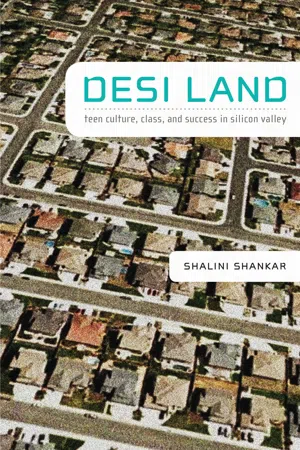
- English
- PDF
- Available on iOS & Android
About This Book
Desi Land is Shalini Shankar's lively ethnographic account of South Asian American teen culture during the Silicon Valley dot-com boom. Shankar focuses on how South Asian Americans, or "Desis, " define and manage what it means to be successful in a place brimming with the promise of technology. Between 1999 and 2001 Shankar spent many months "kickin' it" with Desi teenagers at three Silicon Valley high schools, and she has since followed their lives and stories. The diverse high-school students who populate Desi Land are Muslims, Hindus, Christians, and Sikhs, from South Asia and other locations; they include first- to fourth-generation immigrants whose parents' careers vary from assembly-line workers to engineers and CEOs. By analyzing how Desi teens' conceptions and realizations of success are influenced by community values, cultural practices, language use, and material culture, she offers a nuanced portrait of diasporic formations in a transforming urban region.
Whether discussing instant messaging or arranged marriages, Desi bling or the pressures of the model minority myth, Shankar foregrounds the teens' voices, perspectives, and stories. She investigates how Desi teens interact with dialogue and songs from Bollywood films as well as how they use their heritage language in ways that inform local meanings of ethnicity while they also connect to a broader South Asian diasporic consciousness. She analyzes how teens negotiate rules about dating and reconcile them with their longer-term desire to become adult members of their communities. In Desi Land Shankar not only shows how Desi teens of different socioeconomic backgrounds are differently able to succeed in Silicon Valley schools and economies but also how such variance affects meanings of race, class, and community for South Asian Americans.
Frequently asked questions
Information
Table of contents
- Contents
- Preface and Acknowledgments
- Introduction: Welcome to Desi Land
- 1. California, Here We Come, Right Back Where We Started From
- 2. Defining Desi Teen Culture
- 3. Living and Desiring the Desi Bling Life
- 4. Desi Fashions of Speaking
- 5. Being FOBulous on Multicultural Day
- 6. Remodeling the Model Minority Stereotype
- 7. Dating on the DL and Arranged Marriages
- 8. In the New Millennium
- Postscript
- Appendix 1: Student Interview
- Appendix 2: Faculty Interview
- Appendix 3: Parent and Relative Interview
- Appendix 4: Student Survey
- Notes
- Glossary of Hindi and Punjabi Terms
- Bibliography
- Index